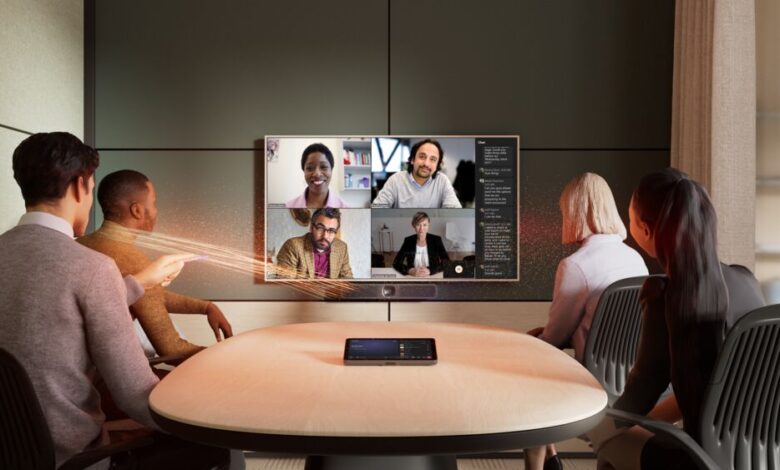
Where and how we work remain heavily debated topics. Without question, the way most of us work has changed, but the tools, environments and expectations haven’t kept up with the pace. Too often, productivity is being compromised by outdated systems that were designed in a time before hybrid and remote working. In turn, forcing a growing gap between technological potential, and the reality of workplace experience.
A more recent development is the emergence of Artificial Intelligence (AI) capabilities and how these intersect with other collaboration tools. We’re witnessing a new era of work, where intelligent systems are rewriting the rules of productivity, inclusion and IT strategy. The companies leading the pack in workplace innovation are the ones no longer just looking at where we work, but how we work, and if our tools and spaces are fit to support.
Smarter meeting rooms
Whether you’re working from home or at the office, meetings are still seen by many companies as a primary way to collaborate. The trouble is they can also drain time and focus, with only 30% of meetings considered productive. Combining smart technology with generative AI is changing this. From intelligent room booking systems to seamless device integration and improved video conferencing hardware, these solutions help ensure meetings start on time, run smoothly and keep teams focused on what matters.
Beyond productivity, these technologies are making collaboration more equal. Real-time transcription means that every voice is heard and captured, and live translation prevents language gaps across global teams. AI-generated summaries support different communication and processing styles, meaning all employees, regardless of location, ability or schedule, stay on the same page.
When combined with intelligent cameras, smart audio systems and ergonomic peripherals, these tools help deeper engagement and more inclusive participation. Intelligent framing gives remote attendees a more equal presence in the room, and flexible interaction modes accommodate neurodiverse team members or those with different working needs.
Focusing on inclusivity is both a moral imperative as well as a strategic one. Most inclusive designs benefit everyone, not just those with specific needs. A workspace with clear visuals, minimal distractions and intuitive interfaces enhances focus and collaboration. By embedding accessibility into workplace tech, companies are not only improving outcomes, but they’re also building a culture where everyone can benefit.
Challenges and opportunities
As generative AI and smart collaboration tools become more embedded into workplace infrastructure, IT leaders are navigating a new dynamic. Traditionally focused on uptime, device management and helpdesk support, IT now plays a strategic role in driving transformation, securing data and enabling seamless hybrid collaboration.
Today, IT teams need to prepare their organisations to be AI-ready. That includes everything from assessing infrastructure compatibility to understanding how AI interacts with data. Smart meeting platforms can now generate insights, transcription and recordings at scale, so data privacy, security and compliance are now more of a consideration than ever. IT leaders are being asked to safeguard sensitive information and to develop clear governance around how AI outputs are stored, accessed and used.
There’s also a growing need for integrated device management. Hybrid workers rely on a broader ecosystem of peripherals such as headsets, webcams, conference cams and docking stations, so IT teams need tools to remotely monitor, update and troubleshoot devices across distributed teams. Logitech Sync, for example, allows IT admins to manage thousands of devices across global offices from a single dashboard, helping ensure consistent performance and reducing the burden on support teams.
But these challenges also open up new opportunities. With the right tools and framework, IT can be used for productivity. Leaders who embrace AI-enhanced collaboration infrastructure are helping shape the future of how work gets done. With this in mind, the next generation of workplace technology won’t just be smarter. It will be more adaptive, more secure and more human-centred, and IT will be at the heart of delivering that transformation.
Designing the future of work
As organisations look to the future, one thing is clear: the workplace has to now be defined by the quality of connection, collaboration and inclusivity it enables. Generative AI and smart meeting technologies are the basis for how teams engage.
But adopting these tools isn’t just a matter of plug-and-play. Success requires intentional design; of both technology ecosystems and the experiences they support, which means creating environments where every employee, regardless of location or ability, can contribute fully. It means enabling real-time insights that accelerate decision-making while keeping data secure, and equipping IT leaders with the visibility and control they need to scale innovation sustainably.
So, the question isn’t whether AI will shape the future of work. It’s whether we are ready to shape it for the benefit of businesses and employees. This is the opportunity to build a workplace that’s not just smarter, but fairer, more flexible and better suited to the realities of how people work today.





